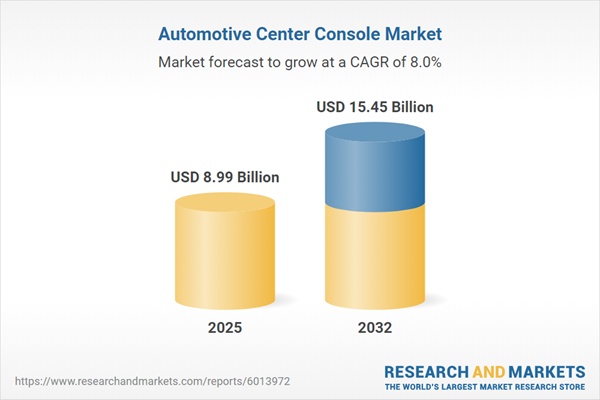Speak directly to the analyst to clarify any post sales queries you may have.
The automotive center console market is experiencing rapid transformation as digital advancements, evolving consumer expectations, and emerging regulatory trends reshape industry priorities. Senior decision-makers are now optimizing strategies to drive innovation, enhance compliance, and maintain robust competitive positions across diverse global markets.
Market Snapshot: Automotive Center Console Market
The global automotive center console market is set for robust growth, with revenue forecasted to rise from USD 8.32 billion in 2024 to USD 8.99 billion in 2025 and reaching USD 15.45 billion by 2032, exhibiting a compound annual growth rate (CAGR) of 8.04%.
This expansion is driven by widespread adoption of digital dashboards, increased occupant connectivity, and ongoing advancements in adaptive cabin technologies. Major suppliers are recalibrating their operations to incorporate electrification and the latest in human-machine interfaces. Industry players are also boosting digital platform investments and forming partnerships that streamline their ability to meet fast-changing market requirements, ensuring compliance and operational efficiency across dynamic supply chains.Scope & Segmentation
- Vehicle Types: Solutions tailored for heavy commercial vehicles, light commercial vehicles, passenger cars, and SUVs, with each segment reflecting specialized user needs and regulatory constraints.
- Material Types: Wide-ranging use of leather, metals, plastics, and wood trim supports strategic objectives around sustainability, competitive brand positioning, and flexible product offerings for eco-conscious or premium buyers.
- Technology Adoption: Integration of familiar controls with new touch-based interfaces, advanced capacitive and resistive screens, and wireless charging options enhances both interaction and connectivity within the cabin.
- Price Ranges: Economy, mid-range, and luxury console options enable manufacturers and suppliers to align offerings with varying customer budgets and organizational goals.
- Console Types: Floor, overhead, and under-seat configurations are available to meet installation requirements for OEMs and aftermarket providers within diverse vehicle platforms.
- Distribution Channels: Engagement with OEM supply chains as well as aftermarket distribution ensures ongoing support for both new vehicle production and replacement demand across regions.
- Geographic Regions: Market activity spans the Americas, EMEA, and Asia-Pacific, with each region presenting unique adoption patterns, regulatory nuances, and consumer preferences that shape product design and compliance.
- Key Industry Players: Leading organizations such as Faurecia S.A., Magna International Inc., Lear Corporation, and Adient plc are advancing the supply chain through improved operations and targeted differentiation efforts.
Key Takeaways
- Automotive center consoles are evolving into digital hubs that centralize command and information, improving the overall in-vehicle experience as well as operational efficiency for manufacturers.
- Forward-looking product strategies emphasize modularity, advanced touch technologies, and seamless wireless integration, supporting the rapid adaptation to changing technology and customer preferences within automotive lineups.
- Diversifying material sourcing not only furthers sustainability goals but also enables greater customization, appealing to both environmentally minded and premium-focused buyers.
- Flexible design methodologies allow suppliers to quickly respond to region-specific regulatory shifts, balancing the need for compliance with ongoing product innovation.
- Regional approaches emphasize digital connectivity and safety in the Americas, strict adherence to quality and regulatory compliance in EMEA, and accelerated adoption of interactive features in the Asia-Pacific region.
Tariff Impact on Supply Chain and Costs
Recent changes to U.S. tariffs are encouraging market participants to reevaluate their supply chain strategies. Measures such as nearshoring, expanding supplier networks, and implementing agile procurement methods are helping companies manage risk, maintain strong cost controls, and uphold reliable delivery for local and international business partners. These tactics are enhancing stability and ensuring ongoing operations amid growing regulatory complexity.
Methodology & Data Sources
The findings in this report are based on primary research with senior management and technology experts within the industry. Insights are further integrated with trade documentation, patent analysis, and continuous regulatory monitoring. Both quantitative data and qualitative perspectives from market participants inform the strategic recommendations presented.
Why This Report Matters: Automotive Center Console Market
- Guides leadership in aligning investments with modular, digital, and sustainable cockpit solutions that match business strategies and compliance standards.
- Provides a framework for proactive risk management and adaptive planning as supply chain and regulatory environments evolve.
- Delivers crucial competitive benchmarks and intelligence for maintaining operational resilience in today’s dynamic automotive market.
Conclusion
Enterprises that invest in digital innovation, respond effectively to shifting regulatory and customer expectations, and strengthen industry partnerships are positioned to capitalize on evolving opportunities in the automotive center console market.
Additional Product Information:
- Purchase of this report includes 1 year online access with quarterly updates.
- This report can be updated on request. Please contact our Customer Experience team using the Ask a Question widget on our website.
Table of Contents
3. Executive Summary
4. Market Overview
7. Cumulative Impact of Artificial Intelligence 2025
Companies Mentioned
The companies profiled in this Automotive Center Console market report include:- Faurecia S.A.
- Magna International Inc.
- Lear Corporation
- Adient PLC
- Shanghai Yanfeng Automotive Interiors Systems Co., Ltd.
- Grupo Antolin-Irausa S.A.
- Toyota Boshoku Corporation
- Motherson Sumi Systems Limited
- DENSO Corporation
- Brose Fahrzeugteile SE & Co. KG
Table Information
| Report Attribute | Details |
|---|---|
| No. of Pages | 198 |
| Published | November 2025 |
| Forecast Period | 2025 - 2032 |
| Estimated Market Value ( USD | $ 8.99 Billion |
| Forecasted Market Value ( USD | $ 15.45 Billion |
| Compound Annual Growth Rate | 8.0% |
| Regions Covered | Global |
| No. of Companies Mentioned | 11 |









